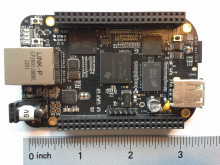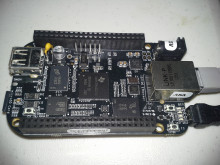Udoo
The Udoo is relatively pricey, but has some great features and is relatively well documented. They bill themselves as a "Raspberry Pi + Arduino", but that is selling themselves a little short. Anyone could plug an Arduino into the USB port of a Raspberry Pi. The ARM processor is faster and more capable than the Raspberry Pi, but also has the same pinout as the Arduino Due with the exception of a few missing pins like the analog ones. Additionally, there is an Arduino Due-like processor that has full access to the same pins. That's right. Both processors can access the same pins. They can access different ones at the same time, or even send signals to each other if you configure it that way.
It features an ARMv7 processor, not ARMv6 like the Raspberry Pi. The newer instruction set means each core of the ARM processor is significantly (2x) faster at many tasks. More importantly, it is the same instruction set supported by popular Linux distrobutions like Ubuntu and Android. The Raspberry Pi's ARMv6 processor is pretty much restricted to the Raspbian Debian derivative.


